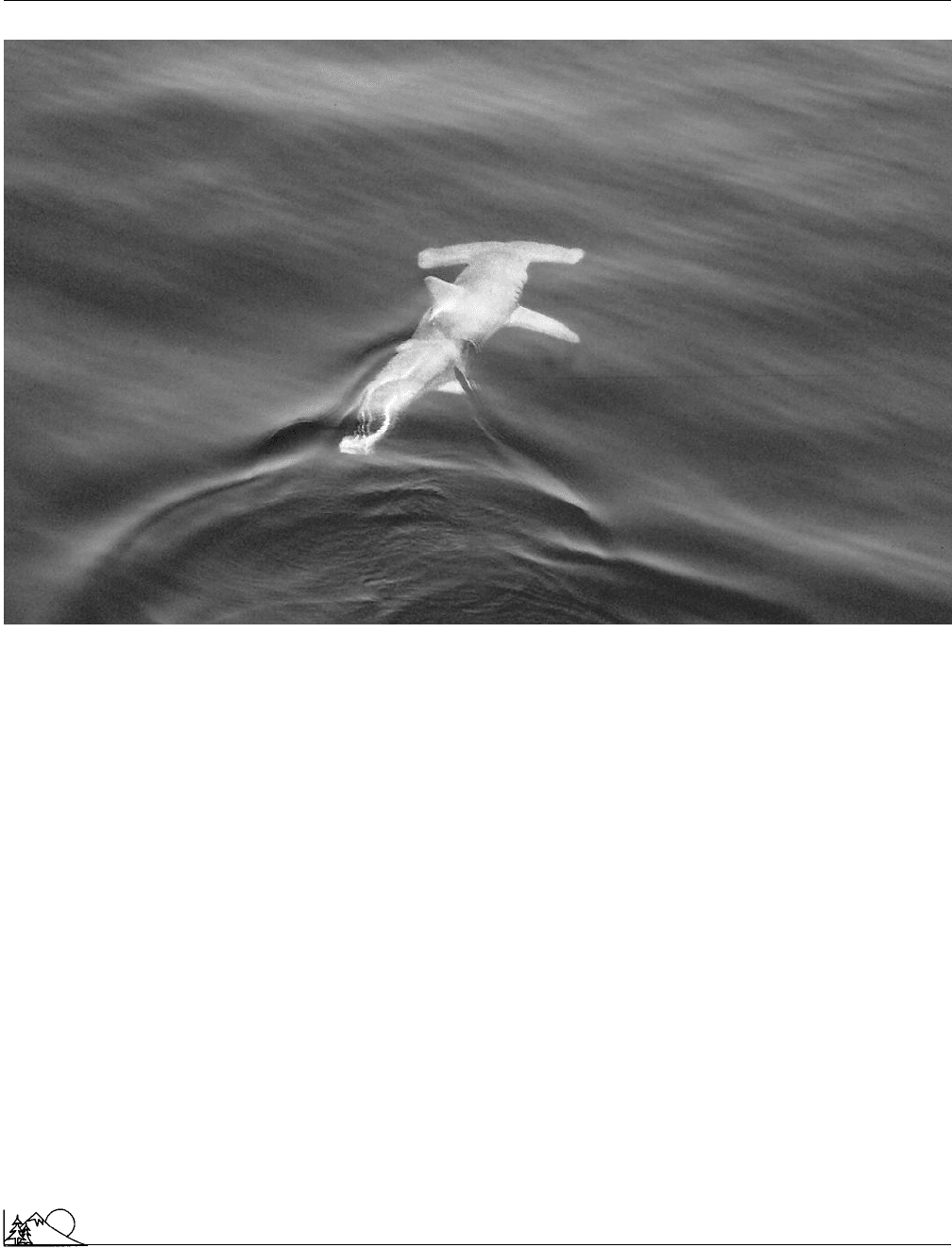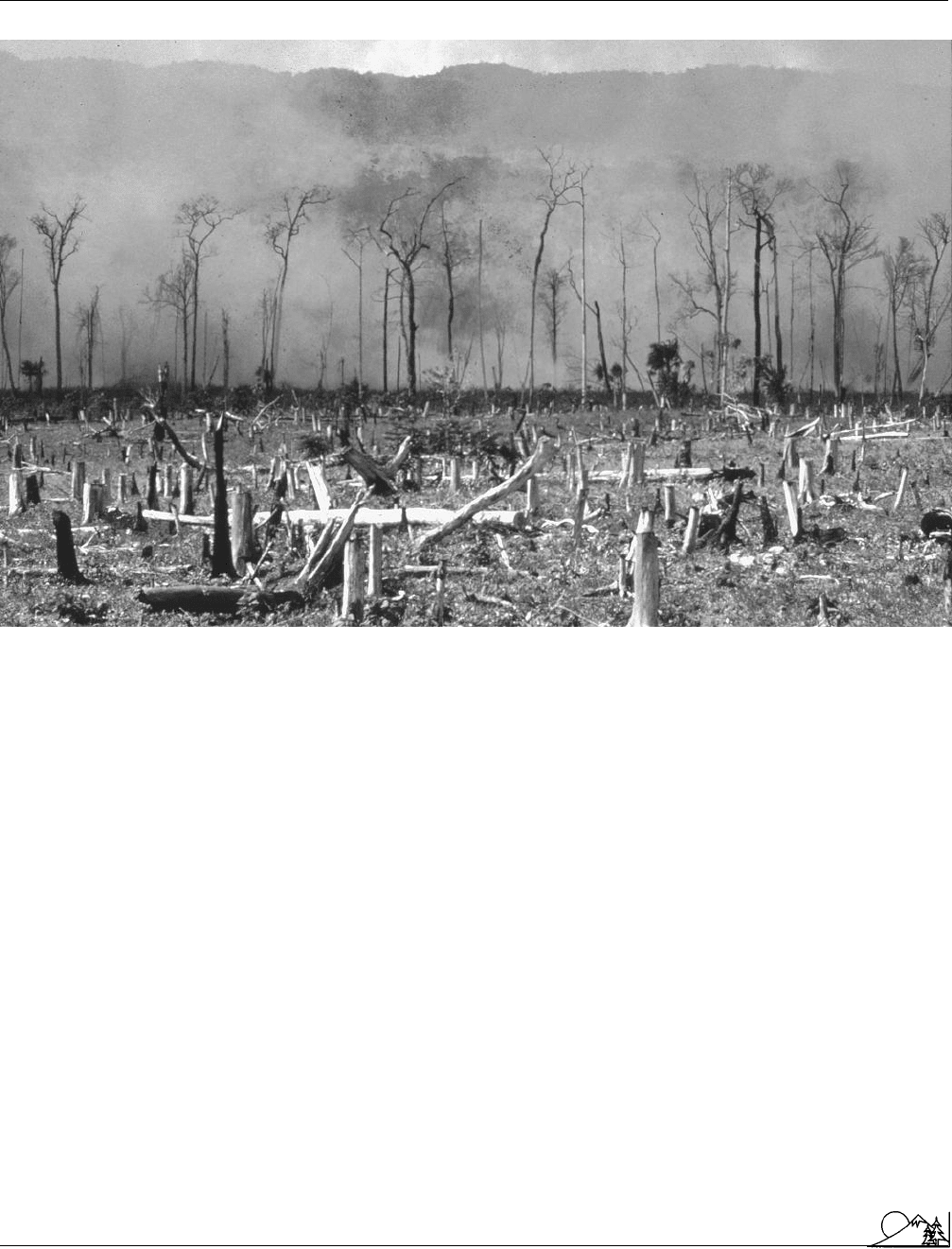Environmental Encyclopedia
Подождите немного. Документ загружается.


Environmental Encyclopedia 3
Sharks
A hammerhead shark swimming just below the water surface. (Photograph by John Bortniak, NOAA Corp. National
Oceanic and Atmospheric Administration.)
is a potential danger to swimming or surfing humans. The
species most often linked with attacks on people are the great
white shark, the tiger shark, and the bull shark (Carcharhinus
leucas). These are all widely distributed species that are
adapted to feeding on
seals
or
sea turtles
, but may also
opportunistically attack humans.
According to data compiled by the International Shark
Attack File, in the year 2001 there were about 76 unprovoked
shark attacks on humans world-wide. This included 54 at-
tacks in U.S. waters, mostly occurring off beaches in Florida.
(This tally does not include “provoked” attacks, as might
happen when a fisher is attempting to remove an entangled
shark from a net or hook, or scavenging damage done to an
already-drowned human.) Only five of those unprovoked
attacks, however, resulted in fatalities (three were in the
United States). This relatively low, 7% fatality rate is thought
to occur because, from the perspective of the shark, an attack
on a human is usually a “mistake” that happens when a
swimmer or surfer is confused with a more usual prey animal,
1287
such as a seal. In such cases, the shark usually breaks off the
attack before lethal damage.
Although there is always a risk of being attacked by
a large shark while swimming or surfing in waters that they
frequent, the actual
probability
of this happening is ex-
tremely small. In the United States, for example, many more
human fatalities are caused by bee and wasp stings and by
venomous snakebites. Even lightning strikes cause about 30
times as many deaths per year as do shark attacks. In fact,
it is much more dangerous to drive to and from a beach in
the United States, compared to the risk of a shark attack
while swimming there.
Although it is a fact that very few humans are hurt
by sharks each year, the reverse is definitely not true. Sharks
are extremely vulnerable to fishing pressure because of their
slow growth rate, length maturation period, and low birth
rate. Consequently,
commercial fishing
practices are devas-
tating populations of many species of sharks throughout the
oceans of the world. In waters of the United States, for

Environmental Encyclopedia 3
Paul Howe Sheppard
example, fishing
mortality
of sharks in recent years has been
equivalent to about 18-thousand tons (20-thousand tonnes)
per year. This is much more than the maximum sustainable
yield calculated by fishery scientists, which is equivalent to
about 9–11-thousand tons (10–15-thousand tonnes) per
year. Because of this intense
overfishing
, there has been a
catastrophic decline in the numbers of sharks in U.S. territo-
rial waters, by as much as 80% since the 1970s and 1980s.
A similar decrease is also occurring in many other regions
of the world, and for the same reasons.
The excessive killing of sharks is occurring for several
reasons. Some species of sharks, such as the spiny dogfish,
are commercial species caught for their meat. Larger species
of sharks may be caught in large numbers solely for their
fins, which are cut off and sold as a delicacy in certain Asian
markets, particularly in China. Shark “finning” is a widely
illegal but common practice. It is also extremely wasteful as
the de-finned sharks are thrown back into the sea, either as
dead carcasses or as live fish doomed to starve to death
because they are incapable of swimming properly. As many
as 30–100 million sharks may be subjected to this finning
practice each year. There are also economically significant
recreational fisheries for sharks, involving sportsmen catch-
ing them as trophies.
In addition to sharks being targets of commercial and
recreational fisheries, immense numbers are also incidentally
caught as so-called “bycatch” in fisheries targeted for other
species of fish. This is especially the case in long-line fisheries
for large tuna and
swordfish
. This open-ocean fishing
method, mostly practiced by boats fishing for Japan, Korea,
and Taiwan, involves setting tens of miles of line containing
thousands of baited hooks. This is a highly non-selective
practice that kills enormous numbers of species that are not
the intended target of the fishery, including many sharks.
Some fishery biologists believe that the
bycatch
mortality
of sharks, about 12-million animals per year, may be at least
half the size of the commercial fishery of these animals. This
excessive bycatch of sharks, almost all of which is discarded
at sea as “waste,” is further contributing to the devastation
of their populations. The World Conservation Union
(IUCN) lists numerous species of sharks as being at risk of
endangerment or
extinction
.
In a few places, sharks are contributing to the local
economy in ways that do not require the destruction of these
marvelous animals. This is happening through
ecotourism
involving recreational diving with sharks in non-threatening
situations. For instance, waters off Cocos Island, Costa Rica,
sustain large numbers of whitetip reef sharks (Triaenodon
obesus), hammerheads (Sphyrna zygaena), and whale sharks
(Rhincodon typus), and this is a local attraction for scuba-
diving tourists.
[Bill Freedman Ph.D.]
1288
R
ESOURCES
B
OOKS
Compagno, L. J. V. Sharks of the World. New York: UN Food and Agricul-
tural Organization and UN Development Programme, 1984.
Springer, V. G., and J. P. Gold. Sharks in Question: The Smithsonian Answer
Book. Washington, DC: Smithsonian Institution Press, 1989.
Stevens, J. D., ed. Sharks. New York: Facts on File Publications, 1987.
O
THER
Public Broadcasting Service. The World of Sharks. [cited July 2002]. <http://
www.pbs.org/wgbh/nova/sharks/world>.
Shark Specialist Group. [cited July 2002].<http://www.flmnh.ufl.edu/fish/
Organizations/SSG/SSGDefault.html>.
The Pelagic Shark Research Foundation. [cited July 2002]. <http://www.pela-
gic.org>.
The University of Florida. The International Shark Attack File. [cited July
2002]. <http://www.flmnh.ufl.edu/fish/Sharks/ISAF/ISAF.htm>.
Sheet erosion
see
Erosion
Paul Howe Sheppard (1925 – 1996)
American environmental theorist
A scientist, teacher, and environmental theorist, Shepard
moved beyond the factual realm of biological science to
expand upon the nature of human behavior and its roots in
the natural world. He was a prolific writer who have had a
profound influence on a variety of contemporary thinkers.
In his introduction to The Subversive Science: Essays
Toward an Ecology of Man, edited with Daniel McKinley,
Shepard discussed the reluctance of modern (as opposed to
primitive) people to view humanity as one element of the
whole of creation. Instead, humanity is wrongly seen as
the singular focus or the intended culmination of creation,
thereby denying the role played by all other life forms in
the
evolution
of humankind. Shepard suggested this need
to dominate has led to physical and mental separation from
the whole, resulting in innumerable problems for hu-
mankind, among them
environmental degradation
.He
believed that people should simultaneously appreciate the
integrity of every being as well as the relatedness of all things,
acquiring a world view that is inclusive and holistic rather
than exclusive and superficially hierarchical: “Without losing
our sense of a great human destiny and without intellectual
surrender, we must affirm that the world is a being, a part
of our own body.”
Shepard continued to assess and emphasize the rela-
tionships between other living things and human develop-
ment, particularly the role played by animals. In The Others:
How Animals Made Us Human, he discusses the paradox of
people who both love and kill or hunt animals, and contrasts

Environmental Encyclopedia 3
Shoreline armoring
them with those who would protect the “others” of the
natural world from humans in the name of “animal rights:”
“In the perspective of the enormous history of life and the
role of animals in human evolution for a million years, I feel
only disconnected by the precept of untouchability...Great
naturalists and primal peoples were motivated not by the
ideal of untouchability but by a cautious willingness to con-
sume and be consumed, both literally and in a mythic sense.”
Shepard was born on July 12, 1925, in Kansas City,
Missouri; his father was a horticulturist. During World War
II he served in the U.S. Army from 1943–46, in the Euro-
pean theater. He received his B.A. from the University of
Missouri (1949) and his M.S. in
conservation
(1952). His
Ph.D. from Yale (1954) was based on an interdisciplinary
study of
ecology
, landscape architecture, and art history.
Shepard was a Fulbright senior research scholar in New
Zealand in 1961, and later received both a Guggenheim
fellowship to research the cultures of hunting-gathering peo-
ples (1968–69) and a Rockefeller fellowship in the humani-
ties (1979).
For 21 years Shepard taught concurrently at Pitzer
College and Claremont Graduate School (both in Clare-
mont, California), serving as the Avery Professor of Natural
Philosophy and
Human Ecology
at Claremont from 1973
until his retirement in 1994. Earlier he had taught at other
schools, including Knox College, Dartmouth College, and
Smith College. He published numerous books, was a regular
contributor to Landscape and North American Review, and
also wrote for BioScience, Perspectives in Biology and Medicine,
and School Science and Mathematics.
[Ellen Link]
R
ESOURCES
B
OOKS
Contemporary Authors. Vol. 10. Detroit: Gale Research, 1983.
Shepard, Paul. Environmental: Essays on the Planet as a Home. Boston:
Houghton, 1971.
———. Man in the Landscape: A Historic View of the Esthetics of Nature.
New York: Knopf, 1967.
———. Nature and Madness. San Francisco: Sierra Club Books, 1982.
———. The Others: How Animals Made Us Human. Washington, D.C.:
Island Press, 1996.
———. The Tender Carnivore and the Sacred Game. New York:
Scribner, 1973.
———. Thinking Animals: Animals and the Development of Human Intelli-
gence. New York: Viking Press, 1978.
———, and B. Sanders. The Sacred Paw: The Bear in Nature, Myth and
Literature. New York: Viking Press, 1983.
———, and D. McKinley, eds. The Subversive Science: Essays Toward an
Ecology of Man. Boston: Houghton Mifflin, 1969.
———, ed. The Only World We’ve Got: A Paul Shepard Reader. San Fran-
cisco: Sierra Club Books, 1996.
Oelschlaeger, M., ed. The Company of Others: Essays in Celebration of Paul
Shepard. Durango, Co: Kivaki Press, 1995.
1289
P
ERIODICALS
Pace, E. “Paul Shepard, Professor and Author, 71.” New York Times, July
22, 96: A15(L).
Shifting cultivation
Shifting cultivation refers to a practice whereby a tract of
land is alternately used for crop production and then allowed
to return to native vegetation for a period of years. Typically,
the land is cleared of vegetation, crops are grown for two
or three years, and then the land abandoned for a period of
10 or more years. To facilitate land clearing prior to cultiva-
tion, the vegetation is cut and the debris burned. The practice
is also called slash-and-burn agriculture or swidden agri-
culture.
Shifting cultivation is most common in the tropics
where farming techniques are less technologically advanced.
The soils are usually low in plant nutrients. For two or three
years following land clearing, the nutrients brought to, or
near, the
soil
surface by deep rooting trees, shrubs, and other
plants support cultivated crops. With native management,
the available nutrients are removed by the cultivated crops
or leached so that after a few years the soil will support only
minimal plant growth. It is then allowed to return to native
vegetation which slowly concentrates the nutrients in the
surface soil again. After a period of years the cycle repeats.
Erosion
is often severe on sloping land during the cultivated
phase. On some soils, particularly in the tropics, the soil
structure becomes massive and hard. See also Leaching; Soil
compaction; Soil organic matter
[William E. Larson]
R
ESOURCES
B
OOKS
Ramakrishnan, P. S. Shifting Agriculture and Sustainable Development: An
Interdisciplinary Study from North-Eastern India. Park Ridge, NJ: Parthenon
Publishing Group, 1992.
Vasey, D. E. An Ecological History of Agriculture. Ames, IA: Iowa State
University Press, 1992.
P
ERIODICALS
Monastersky, R. “Legacy of Fire: The Soil Strikes Back.” Science News 133
(April 9, 1988): 231.
Shoreline armoring
Shoreline armoring is the construction of barriers or struc-
tures for the purpose of preventing coastal
erosion
and/or
manipulating ocean currents. Although they may prevent
the deterioration of the immediate shoreline, these man-
made structures almost always exacerbate erosion problems

Environmental Encyclopedia 3
Sick Building Syndrome
at nearby, downstream beaches by changing wave patterns
and water flow.
Armoring may also promote the loss of shoreline vege-
tation, which in turn can degrade the
ecosystem
that sea-
birds and other beach and sea-dwelling life depend upon. By
altering water flow and erosion and deposition and creating
physical barriers, some types of shoreline armoring prevent
sea turtles
from reaching their nesting sites on shore. Fi-
nally, shoreline structures can block sunlight imperative to
aquatic plants such as
eelgrass
, a prime
habitat
for herring
and other marine life.
Shoreline erosion is a natural process determined by
a complex array of environmental causes. Weather changes,
tidal currents, and sea level adjustments all impact erosion
over time. Catastrophic weather events such as hurricanes,
tsunamis
, and tropical storms can completely change the
shape and nature of the coast in one fell swoop. Beach
location, currents, and other conditions may also create de-
positional shorelines, where sand and
sediment
collect
rather than erode. Armoring is a human attempt to minimize
the impact of these natural forces on an isolated section of
coastal shoreline. Because the coastal ecosystem is extensive
and interconnected, these attempts ultimately affect other
nearby, unprotected locations.
Common types of shoreline armoring include
O
Groins. Long barriers that run perpendicular from the
shoreline and are designed to trap sand and deposit it on
the adjacent beach.
O
Jetties. Similar to groins, jetties are rock structures that are
built out from the shoreline. They are often erected for
the purpose of keeping ship or boating channels clear of
sediment build up by directing currents appropriately.
O
Seawalls. These concrete or rock walls act as a barrier
between beach and ocean; but increase neighboring beach
erosion by deflecting normal wave patterns.
O
Bulkheads. Like a seawall, a bulkhead is designed to separate
the also promotes erosion further downstream.
O
Revetments. A small seawall barrier, often constructed from
rocks or boulders.
O
Breakwaters. Breakwaters are offshore structures that ab-
sorb much of the force of waves before they reach the
shoreline. They sometimes serve a dual purpose as naviga-
tional aids in boating channels.
O
Rip Rap. Rip rap is a rock armoring sometimes used on
river beds as well as coastal slopes to deter erosion.
O
Docks. Although they are not built for the purpose of pre-
venting coastal erosion, boat dock structures do impact
marine life by blocking sunlight crucial for vegetation. Pil-
ings, or posts, for docks can also disrupt sea-floor sedi-
ments. Depending on their size, structure, and location,
they can also influence natural water flow patterns.
1290
Alternatives to shoreline armoring include main-
taining or planting native coastal shrubs, trees, and other
plants that have an established root system to help prevent
erosion.
Beach renourishment
, the process of replacing
eroded beach with dredged offshore sand, is also used for
erosion management. However, renourishment is cost-pro-
hibitive in many cases, and may have a negative impact on
marine
flora
and
fauna
. It also requires ongoing mainte-
nance, as erosion is a perpetual process. Finally, the reloca-
tion of structures placed at risk by severe erosion, sometimes
referred to as a retreat strategy, allows the natural processes of
shoreline
evolution
to continue while preserving the public
interest.
Shoreline armoring is becoming more widely recog-
nized as an environmental hazard rather than a help. In
South Carolina, state legislation entitled the 1988
Beachfront Management Act established a retreat rather
than armor strategy for dealing with shoreline changes. The
Act states that “[t]he use of armoring in the form of hard
erosion control devices such as seawalls, bulkheads, and rip
rap to protect erosion-threatened structures adjacent to the
beach has not proven effective. These armoring devices have
given a false sense of security to beachfront property owners.
In reality, these hard structures, in many instances, have
increased the vulnerability of beachfront property to damage
from wind and waves while contributing to the deterioration
and loss of the dry sand beach which is so important to
the tourism industry.” South Carolina no longer allows the
construction of shoreline armoring within its coastal set-
back area, nor the rebuilding of existing armoring that is
more than two-thirds damaged.
[Paula Anne Ford-Martin]
R
ESOURCES
B
OOKS
Dean, Cornelia. Against the Tide: The Battle for America’s Beaches. New
York: Columbia University Press, 2001.
P
ERIODICALS
Dunn, Steve, et al. “Coastal Erosion: Evaluating the Risk.” Environment
42, no. 7 (September 2000): 36 (10).
O
THER
South Carolina General Assembly. Beachfront Management Act of 1988.
S.C. Code of Regulations. Chapter 30, Section 48-39-320(B). 1998 [cited
June 6, 2002]. <http://www.lpitr.state.sc.us/coderegs/c030.htm#30-21>.
Sick Building Syndrome
Sick Building Syndrome (SBS) is a term applied to a building
that makes its occupants sick because of indoor air pollutants.
Indoor air quality
(IAQ) problems fall into three categories:
SBS, building-related illnesses, and
multiple chemical sen-

Environmental Encyclopedia 3
Sierra Club
sitivity
. Of the three, SBS accounts for 75% of all IAQ
complaints.
Indoor air is a health hazard in 30% of all buildings,
according to the World Health Organization. The
Environ-
mental Protection Agency
(EPA) lists IAQ fourth among
top
environmental health
threats. The problem of SBS is
of increasing concern to employees and occupational health
specialists, as well as landlords and corporations who fear
the financial consequences of illnesses among tenants and
employees.
Respiratory diseases
attributed to SBS account
for about 150 million lost work days each year, $59 billion
in indirect costs, and $15 billion in medical costs.
Sick building syndrome was first recognized in the
1970s around the time of the energy crisis and the move
toward
conservation
. Because heating and air conditioning
systems accounted for a major portion of energy consump-
tion in the United States, buildings were sealed for
energy
efficiency
. Occupants depend on mechanical systems rather
than open windows for outside air and ventilation. A tight
building, however, can seal in and create contaminants.
Common complaints of SBS include headaches, fatigue,
cough, sneezing, nausea, difficulty concentrating, bleary eyes,
and nose and throat irritations. Symptoms are caused by a
range of contaminants, including volatile organic compounds
(VOC), which are
chemicals
that turn to gas at room tem-
perature and are given off by paints, adhesives, caulking,
vinyl, telephone cable, printed documents, furniture, and
solvents. Most common VOCs are
benzene
and chloro-
form, both of which may be carcinogens. Formaldehyde in
building materials also is a culprit.
Biological agents such as viruses, bacteria, fungal
spores, algae, pollen, mold, and dust mites add to the prob-
lems. These are produced by water-damaged carpet and
furnishing or standing water in ventilation systems, humidi-
fiers, and flush
toilets
.
Carbon dioxide
levels increase as the number of peo-
ple in a room increases, and too much can cause occupants
to suffer hyperventilation, headaches, dizziness, shortness of
breath, and drowsiness, as does
carbon monoxide
and the
other
toxins
from
cigarette smoke
.
Schoolchildren are considered more vulnerable to SBS
because schools typically have more people per room breath-
ing the same stale air. Their size, childhood allergies, and
asthmas add to their vulnerability.
Sick buildings can be treated by updating and cleaning
ventilation systems regularly and using air cleaners and
filtra-
tion
devices. Also, plants spaced every 100 ft
2
(9.3 m
2
)in
offices, homes, and schools have been shown to filter out
pollutants in recycled air.
A simple survey of the indoor
environment
can detect
many SBS problems. Check each room for an air source; if
windows cannot be opened, every room should have a supply
1291
vent and exhaust vent. Clean the vents. Check to see if air
is circulating by placing a strip of tissue at each vent opening.
The tissue should blow out at a supply vent and blow in at
an exhaust vent. Move partitions, file cabinets, and boxes
away from vents. Supply and exhaust vents should be more
than a few feet apart. Dead spaces where air stagnates and
pollutants build up should be renovated. Move printing and
copying machines away from people and give those machines
adequate exhaust. Check that the ventilation system operates
fully in every season and whenever people are in the building.
The EPA enforces tough laws on outdoor
air pollu-
tion
, but not for indoor air except for some smoking bans.
Yet almost every pollutant, according to the EPA, is at higher
levels indoors than out. Help in detecting and correcting sick
building syndrome is available from the
National Institute
of Occupational Safety and Health
, the federal agency
responsible for conducting research and making recommen-
dations for safe and healthy work standards. See also Occupa-
tional Safety and Health Administration (OSHA); Occupa-
tional Health and Safety Act
[Linda Rehkopf]
R
ESOURCES
B
OOKS
Kay, J. G., et al. Indoor Air Pollution: Radon, Bioaerosols, and VOCs. Chelsea,
MI: Lewis, 1991.
Samet, J. M., and J. D. Spangler. Indoor Air Pollution: A Health Perspective.
Baltimore, MD: Johns Hopkins University Press, 1991.
P
ERIODICALS
Soviero, M. M. “Can Your House Make You Sick?” Popular Science (July
1992): 80.
Sierra Club
The Sierra Club is one of the nation’s foremost
conserva-
tion
organizations and has worked for over 100 years to
preserve “the wild places of the earth.” Founded in 1892 by
author and
wilderness
explorer
John Muir
, who helped
lead the fight to establish
Yosemite National Park
, the
group’s first goal was to preserve the Sierra Nevada mountain
chain. Since then, the club has worked to protect dozens of
other national treasures.
The preserve of Mount Rainier was one of the Sierra
Club’s earliest achievements, and in 1899 Congress made
that area into a
national park
. The group also helped to
establish Glacier National Park in 1910. The Sierra Club
supported the creation of the
National Park Service
in
1916, and in 1919 began a campaign to halt the indiscrimi-
nate cutting of redwood trees.
The club has helped secure many conservation victo-
ries. They worked to create such national parks as Kings

Environmental Encyclopedia 3
Silt
Canyon, Olympic, and Redwood, national seashores such
as Point Reyes in California and Padre Island in Texas, as
well as the Jackson Hole National Monument. The club
also campaigned to expand Sequoia and Grand Teton na-
tional parks. In the 1960s, the Sierra Club helped to secure
such legislative victories as the
Wilderness Act
in 1964,
the establishment of the National Wilderness Preservation
System, and the expansion of the Land and
Water Conser-
vation
Fund in 1968.
By 1970, the Sierra Club had 100,000 members, with
chapters in every state, and the group took advantage of
growing public support for the
environment
to accelerate
progress towards conserving America’s natural heritage. The
National Environmental Policy Act
was passed by Con-
gress that year, and the
Environmental Protection Agency
(EPA) was created. Later, the club helped defeat a proposal
to build a fleet of polluting Supersonic Transports, and they
organized the Sierra Club Legal Defense Fund. In 1976,
the club’s lobbying efforts sped passage of the
Bureau of
Land Management
(BLM) Organic Act, which increased
governmental protection for an additional 459 million acres
(185 ha).
One of the most important victories for the Sierra
Club came in 1980, when a year-long campaign culminated
in passage of the Alaska National Interest Conservation Act,
establishing 103 million acres (41.6 million ha) as either
national parks, monuments, refuges, or wilderness areas.
Superfund legislation was also enacted to clean up the na-
tion’s abandoned toxic waste sites.
The decade of the 1980s, however, was a difficult
one for conservationists. With James Watt as Secretary of
Interior under President Ronald Reagan, and Ann Gorsuch
Burford as EPA administrator, the Sierra Club was placed
in a defensive position. The group focused mainly on pre-
venting environmentally destructive projects and legisla-
tion—for example, blocking the MX missile complex in the
Great Basin (1981), preventing weakening of the
Clean Air
Act
, and stopping BLM from dropping 1.5 million acres
(607,030 ha) from its wilderness inventory in 1983. Despite
government interference, pressure from the public and from
Congress helped the club continue its record of positive
accomplishments, including the designation of 6.8 million
acres (2.7 million ha) of wilderness in 18 states (1984),
new wilderness designations in Alabama, Oklahoma, and
Washington, and the addition of 40 rivers to the National
Wild and Scenic River System.
In 1990, after years of grassroots lobbying, a compro-
mise Clean Air Act was reauthorized, strengthening safe-
guards against
acid rain
and
air pollution
. Current projects
include protecting the last remaining ancient forests of the
Pacific Northwest; preventing oil and gas drilling in the 1.5-
million-acre (607,030-ha) Arctic
National Wildlife Refuge
1292
in Alaska; securing wilderness and park areas in California,
Colorado, Idaho, Montana, Nebraska, North Carolina,
South Dakota, New Mexico, and Utah; and combating
global warming and the depletion of the world’s protective
ozone
layer.
In 2001, the Sierra Club began its hundred and tenth
year of work to protect the environment. By 2002, it had
grown to 700,000 members and had 58 chapters across the
United States, with an annual budget of $38 million. Having
become so large and influential, the Sierra Club is now
considered one of the “big ten” American conservation orga-
nizations. An extensive professional staff is required to oper-
ate this complex organization, and members tend to have
little influence over club policy at the national level. Some
radical activists have criticized mainline organizations of this
kind for being too conservative, too comfortable in their
relationship to established powers, and too willing to com-
promise basic principles in order to maintain power and
prestige. Supporters of the club argue that a spectrum of
environmental organizations is desirable and that different
organizations can play useful roles.
[Lewis G. Regenstein]
R
ESOURCES
O
RGANIZATIONS
Sierra Club, 85 Second St., Second Floor, San Francisco, CA USA
94105-3441 (415) 977-5500, Fax: (415) 977-5799, Email:
information@sierraclub.org, <http://www.sierraclub.org>
Silent Spring
see
Carson, Rachel
Silt
A
soil
separate consisting of particles of a certain equivalent
diameter. The most commonly used size for silt is from 0.05
to 0.002 mm equivalent diameter. This is the size used by the
Soil Science Society of America and the
U.S. Department of
Agriculture
, but others recognize slightly different equiva-
lent diameters. As compared to clay (less than 0.002 mm),
the silt fraction is less reactive and has a low cation exchange
capacity. Because of its size, which is intermediate between
clay and sand, silt contributes to formation of desirable pore
sizes, and the
weathering
of silt minerals provides available
plant nutrients. Wind-blown silt deposits are referred to
as “loess.” See also Soil conservation; Soil consistency; Soil
profile

Environmental Encyclopedia 3
Peter Alfred David Singer
Siltation
The process or action of depositing
sediment
. Sediment is
composed of solid material, mineral or organic, and can be
of any texture. The material has been moved from its site
of origin by the forces of air, water, gravity, or ice and has
come to rest on the earth’s surface. The term siltation does
not imply the deposition of
silt
separates, although the sedi-
ment deposited from
erosion
of agricultural land is often
high in silt because of the sorting action into
soil
separates
during the erosion process.
Silver Bay
Silver Bay, on the Minnesota shore of Lake Superior, be-
came the center of
pollution control
lawsuits in the 1970s
when cancer-causing asbestos-type fibers, released into the
lake by a Silver Bay factory, turned up in the drinking water
of numerous Lake Superior cities. While
pollution
lawsuits
have become common, Silver Bay was a landmark case in
which a polluter was held liable for probable, but not proven,
environmental health
risks.
Asbestos
, a fibrous silicate
mineral that occurs naturally in rock formations across the
United States and Canada, entered Lake Superior in the
waste material produced by Silver Bay’s
Reserve Mining
Corporation
. This company processed taconite, a low-grade
form of iron ore, for shipment across the
Great Lakes
to
steel-producing regions. Fibrous asbestos crystals removed
from the purified ore composed a portion of the plant’s waste
tailings
. These tailings were disposed of in the lake, an
inexpensive and expedient disposal method. For almost 25
years the processing plant discharged wastes at a rate of
67,000 tons per day into the lake.
Generally clean, Lake Superior provides drinking
water to most of its shoreline communities. However, water
samples from Duluth, Minnesota, 50 mi (80.5 km) south-
west of Silver Bay, showed trace amounts of asbestos-like
fibers as early as 1939. While the term “asbestos” properly
signifies a specific long, thin crystal shape that appears in
many mineral types, both the long fibers and shorter ones,
known as “asbestos-like” or “asbestiform,” have been linked
to
cancer
in humans.
Early incidences of asbestos-like fibers in drinking
water probably resulted from nearby mining activities, but
fiber concentrations suddenly increased in the late 1950s
when Reserve Mining began its tailing
discharge
into the
lake. By 1965 asbestiform fiber concentrations had climbed
significantly, and municipal water samples in the 1970s were
showing twice the acceptable levels defined by the federal
Occupational Safety and Health Administration
(OSHA). Lawsuits filed against Reserve Mining charged
1293
that the company’s activity endangered the lives of the re-
gion’s residents.
Although industrial discharge often endangers com-
munities, the Silver Bay case was a pivotal one because it
was an early test of scientific uncertainty in cases of legal
responsibility. Cancer that results from exposure to asbestos
fibers appears decades after exposure, and in a large popula-
tion an individual’s
probability
of death may be relatively
small. Asbestos concentrations in Lake Superior water also
varied, depending largely upon weather patterns and city
filtration
systems. Finally, it was not entirely proven that
the particular type of fibers released by Reserve Mining were
as carcinogenic as similar fibers found elsewhere. In such
circumstances it is difficult to place clear blame on the agency
producing the pollutants. The 200,000 people living along
the lake’s western arm were clearly at some risk, but the
question of how much risk must be proven to close company
operations was difficult to answer. Furthermore, the Reserve
plant employed nearly all the breadwinners from nearby
towns. Plant closure essentially spelled death for Silver Bay.
In 1980 a federal judge ordered the plant closed until
an on-land disposal site could be built. Reserve Mining did
construct on-shore tailings ponds, which served the company
for several years until economic losses finally closed the plant
in the late 1980s.
[Mary Ann Cunningham Ph.D.]
R
ESOURCES
P
ERIODICALS
Carter, L. J. “Pollution and Public Health: Taconite Case Poses Major
Test.” Science 186 (October 4, 1974): 31–6.
Sigurdson, E. E. “Observations of Cancer Incidence Surveillance in Duluth,
Minnesota.” Environmental Health Perspectives 53 (1983): 61–7.
Peter Alfred David Singer (1946 – )
Australian philosopher and animal rights activist
Philosopher and leading advocate of the animal liberation
movement, Singer was born in Melbourne,
Australia
. While
teaching at Oxford University in England, Singer encoun-
tered a group of people who were vegetarians not because
of any personal distaste for meat, but because they felt, as
Singer later wrote, that “there was no way in which [mal-
treatment of animals by humans] could be justified ethically.”
Impressed by their argument, Singer soon joined their ranks.
Out of his growing concern for the rights of animals came
the book Animal Liberation, a study of the suffering we inflict
upon animals in the name of scientific experimentation and
food production. Animal Liberation caused a sensation when
it was published in 1972 and soon became a major manifesto

Environmental Encyclopedia 3
Sinkholes
of the growing animal liberation movement in North
America, Australia, England, and elsewhere.
As a utilitarian, Singer—like his nineteenth-century
forebear and founder of
utilitarianism
, the English philoso-
pher Jeremy Bentham—believes that morality requires that
the total amount of happiness be maximized and pain mini-
mized. Or, as the point is sometimes put, we are morally
obligated to perform actions and promote policies and prac-
tices that produce “the greatest happiness of the greatest
number.” But, Singer says, the creatures to be counted within
this number should include all sentient creatures, animals
as well as humans.
To promote only the happiness of humans and to
disregard the pains of animals Singer calls speciesism—the
view that one
species
, Homo sapiens, is privileged above all
others. Singer likens
speciesism
to sexism and racism. The
idea that one sex or race is innately superior to another
has been discredited. The next step, Singer believes, is to
recognize that all sentient creatures—human and nonhuman
alike—deserve moral recognition and respect. Just as we do
not eat the flesh or use the skin of our fellow humans, so,
Singer argues, should we not eat meat or wear fur from
animals. Nor is it morally permissible for humans to kill
animals, to confine them, or to subject them to lethal labora-
tory experiments.
Although Singer’s conclusions are congruent with
those of
Tom Regan
and other defenders of
animal rights
,
the route by which he reaches them is quite different. As a
utilitarian, Singer emphasizes sentience, or the ability to
experience pleasure and pain. Regan, by contrast, emphasizes
the
intrinsic value
or inherent moral worth of all living
creatures. Despite their differences, both have come under
attack from the fur industry, defenders of “factory farming,”
and advocates of animal experimentation. Singer remains a
key figure at the center of this continuing storm.
[Terence Ball]
R
ESOURCES
B
OOKS
Ball, T., and R. Dagger. “Liberation Ideologies.” In Political Ideologies and
the Democratic Ideal. New York: Harper-Collins, 1991.
Singer, Peter. A Darwinian Left: Politics, Evolution, and Cooperation. New
Haven, CT: Yale University Press, 2000.
———. Animal Liberation. 2nd ed. New York: Random House, 1990.
———. Ethics into Action: Henry Spim and the Animal Rights Movement.
Latham, MD: Rowman & Littlefield, 1998.
———. Practical Ethics. New York: Cambridge University Press, 1979.
———. Writings on an Ethical Life. New York: Ecco Press, 2000.
———, and Helga Kuhse, eds. Bioethics: An Anthology. Malden, MA:
Blackwell Publishers, 1999.
———, and T. Regan, eds. Animal Rights and Human Obligations. Engle-
wood Cliffs, NJ: Prentice-Hall, 1976.
1294
Sinkholes
Sinkholes are one of the main landforms in karst
topogra-
phy
, so named for the region in Yugoslavia where solution
features such as caves, caverns, disappearing streams and
hummocky terrain predominate. Karst features occur pri-
marily in limestone but may also occur in dolomite, chert,
or even gypsum (Alabaster Caverns in Oklahoma).
As the name implies, sinkholes are depressions formed
by solution enlargement or the
subsidence
of a cavern roof.
Subsidence may occur slowly, as the cavern roof is gradually
weakened by solution, or rapidly as the roof collapses. Several
of the latter occurrences have gained widespread coverage
because of the size and amount of property damage involved.
An often-described sinkhole formed during May 1981
in Winter Park, Florida, swallowing a three-bedroom house,
half a swimming pool, and six Porsches in a dealer’s lot. The
massive “December Giant” occurred near Montevallo, Ala-
bama, and measured 400 ft (122 m) wide by 50 ft (15 m) deep.
A nearby resident reported hearing a roaring noise and break-
ing timbers, as well as feeling earth tremors under his house.
Cenotes is the Spanish name for sinkholes. One sacred
cenote at the Mayan city of Chichen Itza in Yucatan, Mex-
ico, was known as “the Well of Sacrifice.” Archaeologists
postulate that, to appease the gods during a
drought
, human
sacrifices were cast into the water 80 ft (24 m) below, fol-
lowed by a showering of precious possessions from onlookers.
Since most of the gold and silver objects from the New
World were melted down, these sacrifices are now highly
prized artifacts from pre-Columbian civilizations.
Although occurring naturally, sinkhole formation can
be intensified by human activity. These sinkholes offer an
easy pathway for injection of contaminated
runoff
and sew-
age from septic systems into the
groundwater
. Because
karst landscapes have extensive underground channels, the
polluted water often travels considerable distances with little
filtration
or chemical modification from the relatively inert
limestone. Therefore, the most serious hazard posed by sink-
holes is the access they provide for turbid, polluted surface
waters. This allows bacteria to thrive, so testing of spring
water that emerges within or below karst regions is vital.
Sinkholes also pose special problems for construction
of highways, reservoirs, and other massive objects. Fluctuat-
ing water levels weaken the overlying rock when the
water
table
is high, but remove support when water levels are low.
Thornbury (1954) described the problems resulting from
efforts by Bloomington, Indiana, to build a water supply
reservoir
on top of karst topography. Much valuable water
escaped through channels in the limestone beneath the dam.
This structure eventually was abandoned and a new reservoir
constructed in a region composed of relatively impervious
siltstone below the limestone.

Environmental Encyclopedia 3
Slash and burn agriculture
Anthropogenic
(human-caused) sinkholes form as a
result of mine subsidence, often catastrophically. Collapsing
mine tunnels within the 1,000-mi (1,600-km) labyrinth in
the historic Tri-State Mines of Kansas, Missouri, and Okla-
homa have created scenarios very similar to the Winter Park,
Florida, example. Subsidence of the strata overlying under-
ground
coal
mines is another rich source of these anthropo-
genic sinkholes.
[Nathan H. Meleen]
R
ESOURCES
B
OOKS
Coates, D. R., ed. Environmental Geomorphology. Binghampton, NY: State
University of New York, 1971.
Keller, E. A. Environmental Geology. 4th ed. Columbus, OH: Charles E.
Merrill Publishing Co., 1985.
Thornbury, W. D. Principles of Geomorphology. New York: John Wiley &
Sons, 1954.
P
ERIODICALS
“Into the Well of Sacrifice,” National Geographic Magazine (October 1961):
540–561.
Site index
A means of evaluating a forest’s potential to produce trees
for timber. Site refers to a defined area, including all of
its environmental features, that supports or is capable of
supporting a stand of trees. Site index is an indicator used
to predict timber yield based on the height of dominant and
co-dominant trees in a stand at a given index age, usually
50 or 100 years. Normally, site index curves are prepared by
graphically plotting projected tree height as a function of
age. See also Forest management
Site remediation
see
Hazardous waste site remediation
Skidding
A technique in forest harvesting by which logs or whole
trees are dragged over the ground, as opposed to being lifted
in the air, to a landing, where they are loaded on trucks for
transport to a mill. The logs may be dragged by mechanical
means, such as a crawler tractor or rubber-tired skidder, or
by draft animals. Skidding normally disturbs the ground
surface and forms “skid trails” which may be used once or
reused in subsequent harvests.
Soil
in skid trails, especially
on steep land, may channel water flow during rainfall and
snow melt and be susceptible to
erosion
.
1295
SLAP suits
see
Strategic lawsuits to intimidate public
advocates
Slash
The waste material, consisting of limbs, branches, twigs,
leaves, or needles, left after forest harvesting.
Logging
slash
left on the ground can protect the
soil
from raindrop impacts
and
erosion
, and it can decompose to make
humus
and
recycle nutrients. Unusually large amounts of slash, which
may present a fire hazard or provide favorable
habitat
for
harmful insects or disease organisms, usually must be reduced
by burning or mechanical chopping.
Slash and burn agriculture
Also known as swidden cultivation or
shifting cultivation
,
slash-and-burn agriculture is a primitive agricultural system
in which sections of forest are repeatedly cleared, cultivated,
and allowed to regenerate over a period of many years. This
kind of cultivation was used in Europe during the Neolithic
period, and it is still widely used by
indigenous peoples
and
landless peasants in the tropical rain forests of South America.
The plots used in slash-and-burn agriculture are small,
typically 1–1.5 acres (0.4–0.6 hectare). They are also poly-
cultural and polyvarietal; farmers plant more than one crop
on them at a time, and each of these crops may be grown
in several varieties. This helps control populations of agricul-
tural pests. The cutting and burning involved in clearing the
site releases nutrients which the cultivated crops can utilize,
and the fallow period, which usually lasts at least as long
as 15 years, allows these nutrients to accumulate again. In
addition to restoring fertility, re-growth protects the
soil
from
erosion
.
Families and other small groups practicing slash-and-
burn agriculture generally clear one or two new plots a year,
working a number of areas at various stages of cultivation
at a time. These plots can be close to each other, even
interconnected, or spread out at a distance through the forest,
designed to take advantage of particularly fertile soils or to
meet different needs of the group. As the nutrients are
exhausted and productivity declines, the areas cleared for
slash-and-burn agriculture are rarely simply abandoned; the
fallow period begins gradually, and
species
such as fruit
trees are still cultivated as the forest begins to reclaim the
open spaces. The forest may contain originally cultivated
species that still yield a harvest many years after the plot has
been overgrown.

Environmental Encyclopedia 3
Sludge
Jungle in Guatemala is burned to clear land for raising corn and cattle. (Photograph by George Holton. Photo Researchers
Inc. Reproduced by permission.)
Although this system of agriculture was practiced for
thousands of years with relatively modest effects on the
environment
, the pressures of a rapidly growing population
in South America have made it considerably less benign.
Population growth
has greatly increased the number of
peasants who do not own their own land; they have been
forced to migrate into the rain forests, where they subsist
practicing slash-and-burn agriculture. In Brazil, the number
of farmers employing this system of agriculture has increased
by more than 15% a year since 1975. A recently released
report by the United Nations Population Fund has empha-
sized the destruction this system can cause when practiced
on such a large scale and identified it as a threat to species
diversity. See also Agricultural revolution; Agricultural tech-
nology; Agroecology
[Douglas Smith]
Sludge
A suspension of solids in liquid, usually in the form of a liquid
or a
slurry
. It is the residue that results from
wastewater
1296
treatment operations, and typical concentrations range from
0.25 to 12% solids by weight. An estimated 8.5 million dry
tons of municipal sludge is produced in the United States
each year.
The volume of sludge produced is small compared
with the volume of wastewater treated. The cost of sludge
treatment, however, is estimated to be from 25 to 40% of
the total cost of operating a wastewater-treatment plant. In
the design of
sludge treatment and disposal
facilities,
the term sludge refers to primary, biological, and chemical
sludges, and excludes grit and screenings. Primary sludge
results from primary
sedimentation
, while the sources of
biological and chemical sludges are secondary biological and
chemical settling and the processes used for thickening, di-
gesting, conditioning, and dewatering the sludge from the
primary and secondary settling operations.
Primary sludge is usually gray to dark gray in color
and has a strong offensive odor. Fresh biological sludge—
activated sludge, for example—is brownish and has a musty
or earthy odor. Chemical sludge can vary in color depending
on composition and may have objectionable odor. There are
